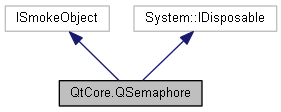|
Qyoto
4.0.5
Qyoto is a C# language binding for Qt
|
|
Qyoto
4.0.5
Qyoto is a C# language binding for Qt
|
The QSemaphore class provides a general counting semaphore. More...


Public Member Functions | |
| QSemaphore (int n=0) | |
| | |
| virtual void | CreateProxy () |
| new void | Acquire (int n=1) |
| | |
| new int | Available () |
| | |
| new void | Release (int n=1) |
| | |
| new bool | TryAcquire (int n=1) |
| | |
| new bool | TryAcquire (int n, int timeout) |
| | |
| new void | Dispose () |
Protected Member Functions | |
| QSemaphore (System.Type dummy) | |
Protected Attributes | |
| SmokeInvocation | interceptor |
Properties | |
| virtual System.IntPtr | SmokeObject [get, set] |
The QSemaphore class provides a general counting semaphore.
A semaphore is a generalization of a mutex. While a mutex can only be locked once, it's possible to acquire a semaphore multiple times. Semaphores are typically used to protect a certain number of identical resources.
Semaphores support two fundamental operations, acquire() and release():
acquire(n) tries to acquire n resources. If there aren't that many resources available, the call will block until this is the case.
release(n) releases n resources.
There's also a tryAcquire() function that returns immediately if it cannot acquire the resources, and an available() function that returns the number of available resources at any time.
Example:
QSemaphore sem(5); // sem.available() == 5
sem.acquire(3); // sem.available() == 2
sem.acquire(2); // sem.available() == 0
sem.release(5); // sem.available() == 5
sem.release(5); // sem.available() == 10
sem.tryAcquire(1); // sem.available() == 9, returns true
sem.tryAcquire(250); // sem.available() == 9, returns false
A typical application of semaphores is for controlling access to a circular buffer shared by a producer thread and a consumer thread. The Semaphores example shows how to use QSemaphore to solve that problem.
A non-computing example of a semaphore would be dining at a restaurant. A semaphore is initialized with the number of chairs in the restaurant. As people arrive, they want a seat. As seats are filled, available() is decremented. As people leave, the available() is incremented, allowing more people to enter. If a party of 10 people want to be seated, but there are only 9 seats, those 10 people will wait, but a party of 4 people would be seated (taking the available seats to 5, making the party of 10 people wait longer).
See also QMutex, QWaitCondition, QThread, and Semaphores Example.
|
protected |
| QtCore.QSemaphore.QSemaphore | ( | int | n = 0 | ) |
Creates a new semaphore and initializes the number of resources it guards to n (by default, 0).
See also release() and available().
| new void QtCore.QSemaphore.Acquire | ( | int | n = 1 | ) |
Tries to acquire n resources guarded by the semaphore. If n > available(), this call will block until enough resources are available.
See also release(), available(), and tryAcquire().
| new int QtCore.QSemaphore.Available | ( | ) |
Returns the number of resources currently available to the semaphore. This number can never be negative.
See also acquire() and release().
|
virtual |
| new void QtCore.QSemaphore.Dispose | ( | ) |
| new void QtCore.QSemaphore.Release | ( | int | n = 1 | ) |
Releases n resources guarded by the semaphore.
This function can be used to "create" resources as well. For example:
QSemaphore sem(5); // a semaphore that guards 5 resources
sem.acquire(5); // acquire all 5 resources
sem.release(5); // release the 5 resources
sem.release(10); // "create" 10 new resources
See also acquire() and available().
| new bool QtCore.QSemaphore.TryAcquire | ( | int | n = 1 | ) |
Tries to acquire n resources guarded by the semaphore and returns true on success. If available() < n, this call immediately returns false without acquiring any resources.
Example:
QSemaphore sem(5); // sem.available() == 5
sem.tryAcquire(250); // sem.available() == 5, returns false
sem.tryAcquire(3); // sem.available() == 2, returns true
See also acquire().
| new bool QtCore.QSemaphore.TryAcquire | ( | int | n, |
| int | timeout | ||
| ) |
Tries to acquire n resources guarded by the semaphore and returns true on success. If available() < n, this call will wait for at most timeout milliseconds for resources to become available.
Note: Passing a negative number as the timeout is equivalent to calling acquire(), i.e. this function will wait forever for resources to become available if timeout is negative.
Example:
QSemaphore sem(5); // sem.available() == 5
sem.tryAcquire(250, 1000); // sem.available() == 5, waits 1000 milliseconds and returns false
sem.tryAcquire(3, 30000); // sem.available() == 2, returns true without waiting
See also acquire().
|
protected |
|
getset |